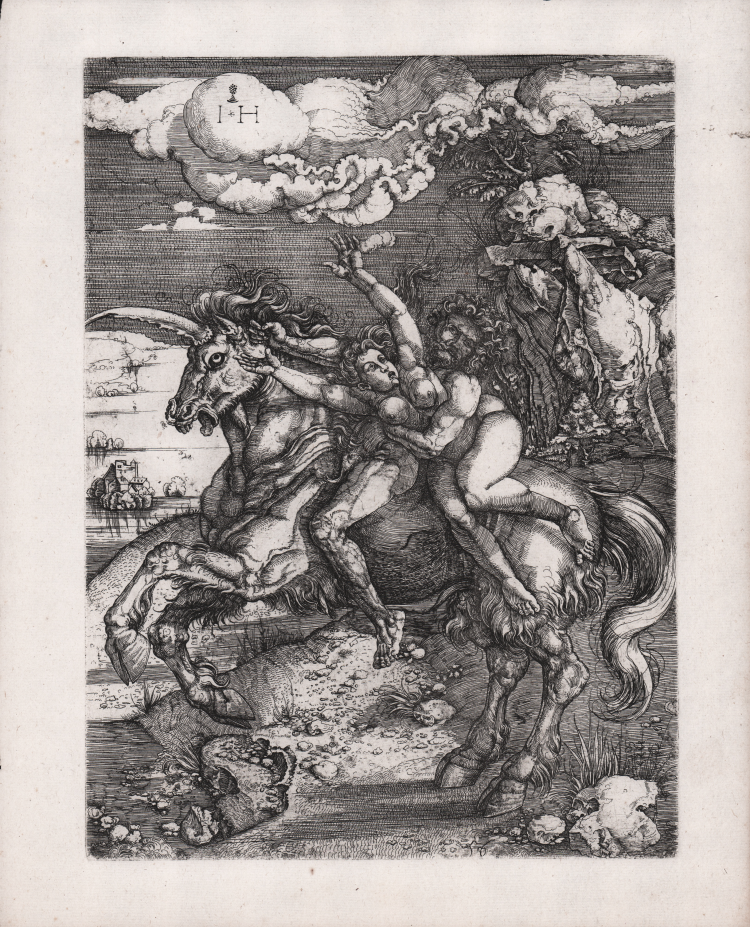



| Reference: | S44313 |
| Author | Hieronimus HOPFER |
| Year: | 1540 ca. |
| Measures: | 215 x 285 mm |


| Reference: | S44313 |
| Author | Hieronimus HOPFER |
| Year: | 1540 ca. |
| Measures: | 215 x 285 mm |
The abduction on the unicorn; copy in reverse after Dürer's etching (Meder 67); male figure on a unicorn grabbing a nude female figure, the unicorn facing left, landscape background.
Etching, circa 1540, signed in the plate at upper left 'I . H'.
The volatile mood of this etching starkly contrasts with the abduction scene in Dürer’s Sea Monster. Here, a woman struggles against her male captor as he carries her away on a menacing unicorn with a jagged horn and cloven hoofs. Although unicorns were generally associated with purity, medieval texts also identified the mythical creature as a symbol of evil or death.
This disturbing image is difficult to interpret. A drawing by Dürer in the Pierpont Morgan Library in New York shows that he made a number of key changes to the image while transferring it to the etching plate. The unicorn was originally a rearing horse, and in the drawing lifeless figures are trampled beneath the horse’s hooves. Neither the drawing nor the print can be firmly tied to a particular myth, although the print is sometimes entitled The Abduction of Proserpina after the story of the abduction of Ceres’s daughter by Pluto. Proserpina, however, is normally shown carried off in Pluto’s chariot or on foot rather than on a unicorn.
This is one of only six etchings known to have been made by Dürer. A new technique in printmaking (although long used to decorate metalwork), etching involved biting lines into an iron plate with acid rather than scraping them with a burin. The earliest surviving print in the technique - by Urs Graf - dates from 1513. Dürer’s brief experimentation with this form of printmaking, between 1515 and 1518, does not appear to have proved particularly satisfying to him, and he soon concentrated on engraving, his preferred method of incising a plate. Such prints as the Abduction may indicate why Dürer abandoned the technique. Although there is a dramatic contrast between light and dark, the plate is essentially difficult to read, with the head of the abductor blending into the rocky prominence behind, and the figure of the naked woman melting into the horse’s flank. Etching, which produces a uniform line, did not allow Dürer to achieve the variety of effect which made his engravings such a technical and critical success.
Hieronymus Hopfer (Augsburg, c. 1500 - Nuremberg, after 1550) was born around 1500 as the second son of Daniel Hopfer. Only few biographical data are known: in 1529 the Augsburg City Council allowed him to go to Nuremberg for a year while, in 1531, Hopfer completely renounced his traditional civil rights and after 1550 he died in Nuremberg. Most of the known works are copies based on woodcuts and engravings by German (Dürer, Cranach) and Italian (Barberi, Campagnola, Mantegna) artists, as well as engravings based on medals and reliefs. Unlike Dürer and the other Nuremberg masters of engraving, Hieronimus Hopfer used to make his works in etching and on iron plate rather than copperplate, a technique in which he was a specialist along with the other members of the engraving family, his father Daniel and brother Lambert Hopfer.
A very good, strong, impression of the second state, printed on laid paper, with margins, perfect condition.
Bibliografia
Hollstein, German engravings, etchings and woodcuts c.1400-1700 (47.II); Bartsch, Le Peintre graveur (VIII.517.42).
Hieronimus HOPFER (Ausburg 1500 ca. - Nurenberg 1536)
|
German family of etchers. In 1497 Daniel Hopfer married Justina Grimm, sister of the publisher and humanist Sigismund Grimm. Daniel’s sons Hieronymus Hopfer and Lambert Hopfer worked with him. Daniel produced more than 130 prints of various subjects for the popular market, Hieronymus 77 and Lambert 34. They placed their initials somewhere within the design on almost all of their prints (D.H., I.H., L.H.), adding a small device which might be a pinecone, from the coat of arms of the city of Augsburg, or a hop blossom, making a punning reference to the family name.
|
Hieronimus HOPFER (Ausburg 1500 ca. - Nurenberg 1536)
|
German family of etchers. In 1497 Daniel Hopfer married Justina Grimm, sister of the publisher and humanist Sigismund Grimm. Daniel’s sons Hieronymus Hopfer and Lambert Hopfer worked with him. Daniel produced more than 130 prints of various subjects for the popular market, Hieronymus 77 and Lambert 34. They placed their initials somewhere within the design on almost all of their prints (D.H., I.H., L.H.), adding a small device which might be a pinecone, from the coat of arms of the city of Augsburg, or a hop blossom, making a punning reference to the family name.
|